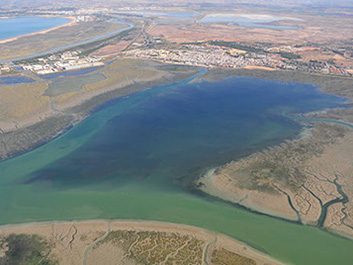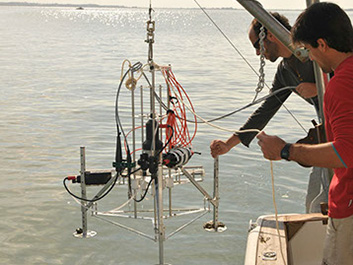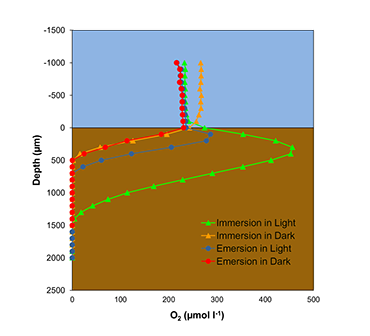Microecology and biogeochemistry of tidal flats in the Bay of Cádiz: Physical forcing by tidal cycle and photoperiod
Project Summary
Intertidal sediments play an important role in the net metabolism and nutrient dynamics of shallow coastal areas. In the inner Bay of Cadiz, the intertidal zone represents 60% of the total sediment surface area. Therefore, the processes occurring within the intertidal sediment, as well as, its interactions with the overlying water column determine to a large extent the ecosystem dynamics of the Bay of Cádiz.
Intertidal areas are largely subjected to two physical forcing factors: solar irradiance and tides, both of which undergo periodic cycles at several temporal scales. However, the effects of the tidal cycle in combination with the daily photoperiod on the microbial ecology and biogeochemical dynamics of intertidal sediments have been little studied.
The main objective of this project is to increase our understanding of the effects of the combined effects of the daily tidal and photoperiod cycles on microbial ecology and biogeochemistry of intertidal sediments, particularly at the sediment –water interface. We will accomplish this objective by quantifying:
- benthic metabolism,
- nutrient cycling in the sediment,
- sediment-water fluxes, and
- benthic microbial community composition, during complete diel and tidal cycles (periods of emersion/immersion and day/night conditions) in both field and microcosm experiments.
We will use several state-of-the-art techniques and instruments: isotope pairing technique, in situ microsensor profiling (MP4 MiniProfiler), core incubations, pyrosequencing, X-ray diffraction, ICP-AA analysis, etc. The proposal includes the technical development of the MP4 MiniProfiler by the addition of a remotely controlled video camera and lighting systems, and a novel acoustic communications system for in situ underwater equipment.
The experimental results obtained during this and from previous projects will be integrated into a coupled biogeochemical-hydrodynamical model to produce better annual estimates of benthic primary production in the Bay of Cádiz. This model will also be of use in other intertidal areas with similar characteristics.
Collaborations
Colleagues participating in the project include:
University of Cádiz, Spain
Department of Biology
Alfonso Corzo Rodríguez, Professor
Julio Bohórquez Ferrando, PhD student
Juan Luis Jiménez Arias, PhD student
Department of Engineering Informatics
Luis Antonio Mariscal Rico, Profesor
Department of Earth Sciences
Angel Sanchez Bellón, Professor
Javier Martínez López, Professor
Department of Applied Physics
Irene Laíz Alónso, Lecturer
Carlos González Mejías, Lecturer
Department of Microbiology
Sokratis Papaspyrou, Lecturer
University of Aarhus, Denmark
Niels Peter Revsbech, Professor
Emilio García Robledo, Postdoctoral Researcher
University of Essex, Dept Biological Sciences, UK
Graham Underwood, Professor
Terry McGenity, Professor
Netherlands Institute of Ecology (NIOO-KNAW), Centre for Estuarine and Marine Ecology, The Netherlands
Filip Meysman, Senior Scientist
CIMAR, Costa Rica
Alvaro Morales Ramírez, Professor
Eddy H. Gomez, PhD student
Publications
José María Crespo Domínguez (2014) Efecto del ciclo mareal en la producción primaria y la dinámica de nutrientes en sedimentos intermareales. Trabajo Fin de Grado, Grado en Ciencias Ambientales, Universidad de Cádiz.
Funding
Microecology and biogeochemistry of intertidal sediments in the Bay of Cádiz: physical forcing by tides and photoperiod (Microecologia y biogeoquimica de los sedimentos intermareales de la Bahia de Cádiz: forzamiento fisico por el ciclo mareal y el fotoperiodo), CTM2013-43857-R, CICYT, Spain (217,800 €). PI: Profs. A. Corzo & L. Mariscal, 2014-2016.






